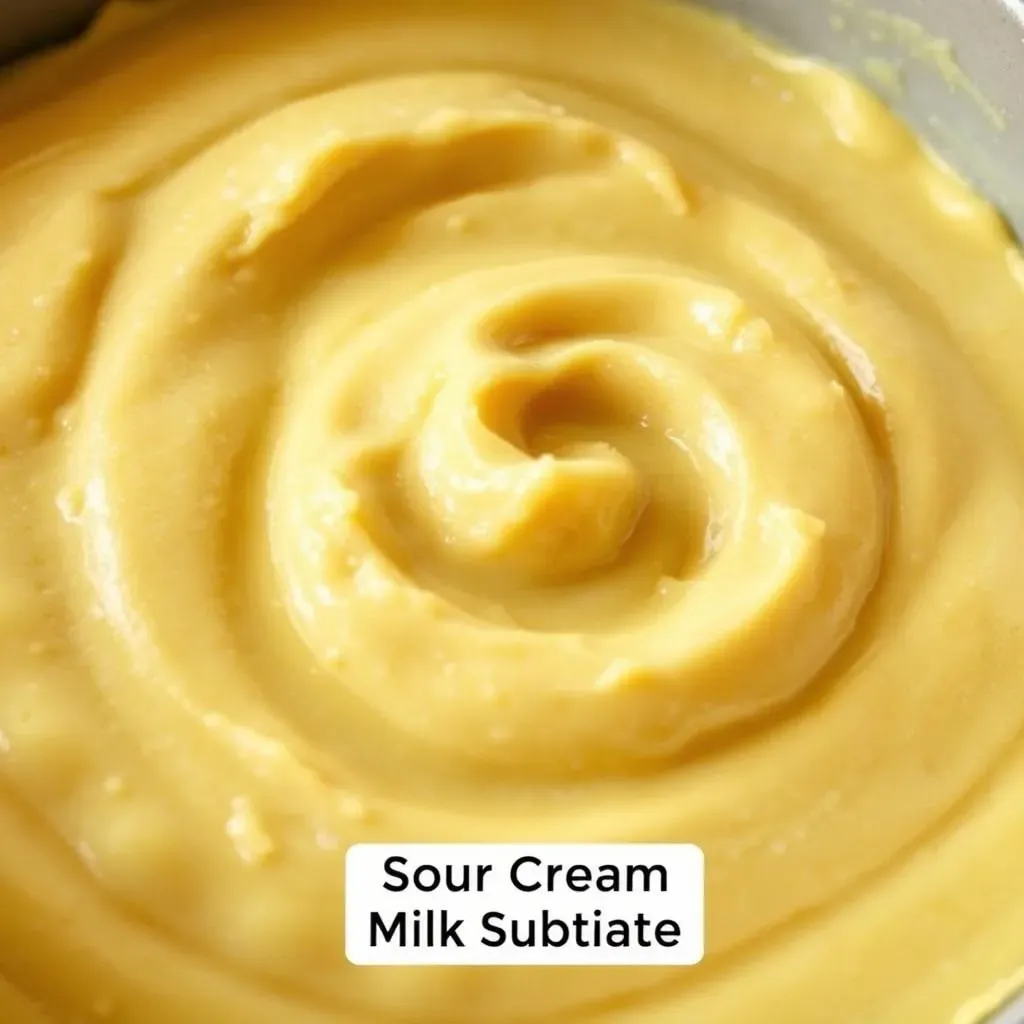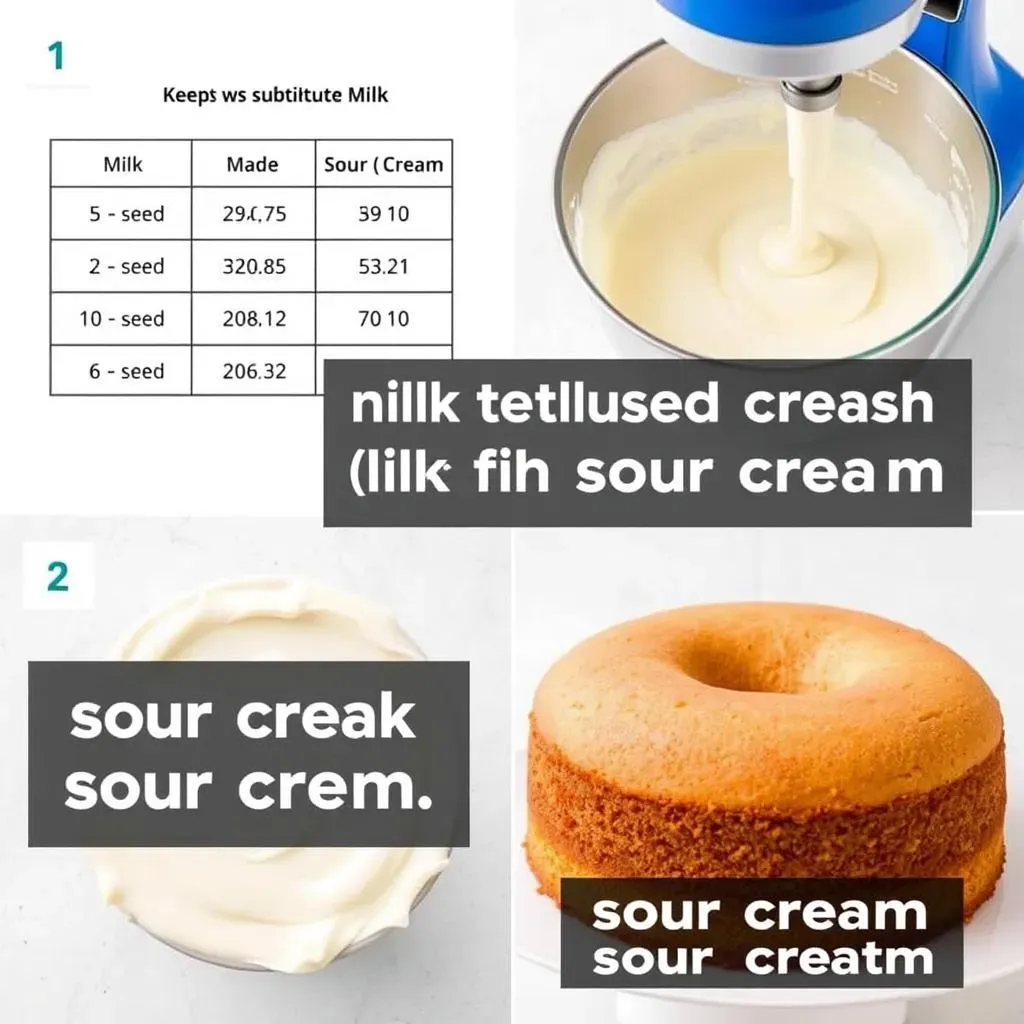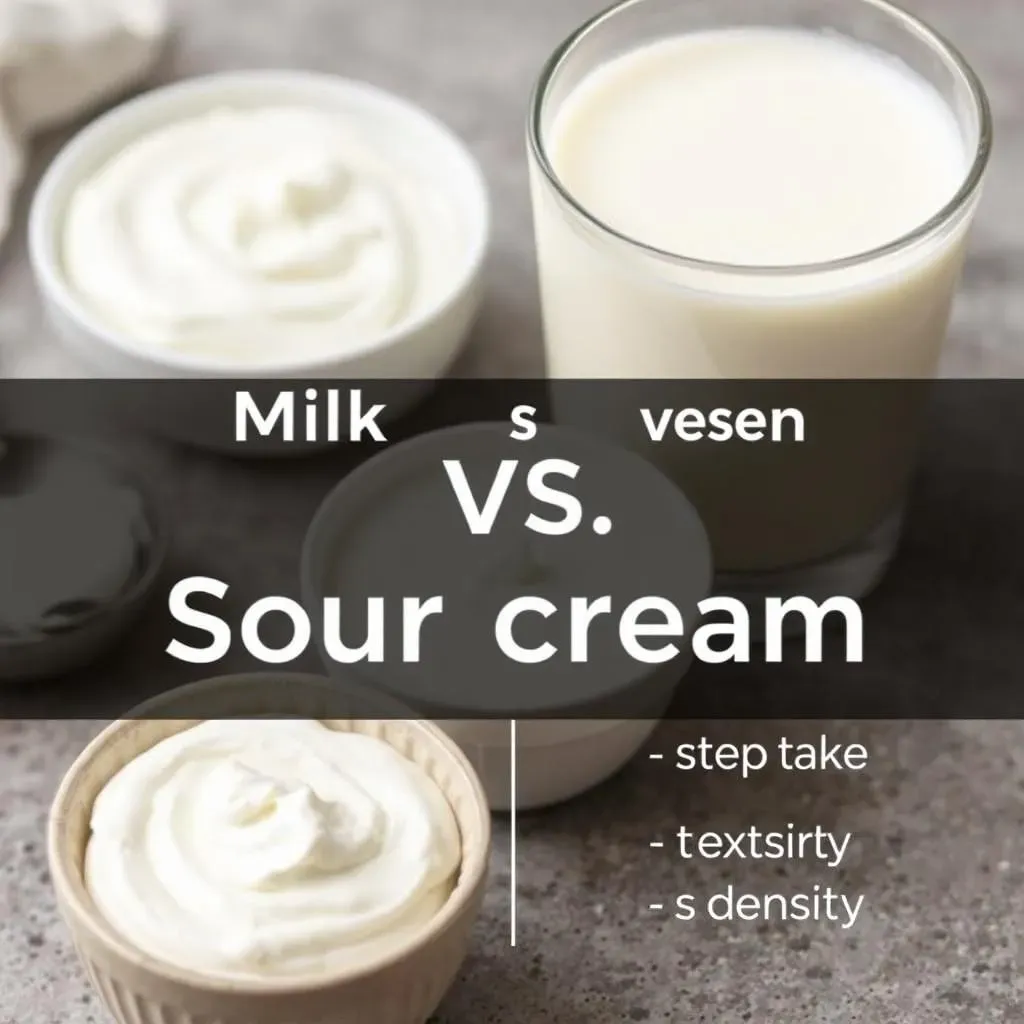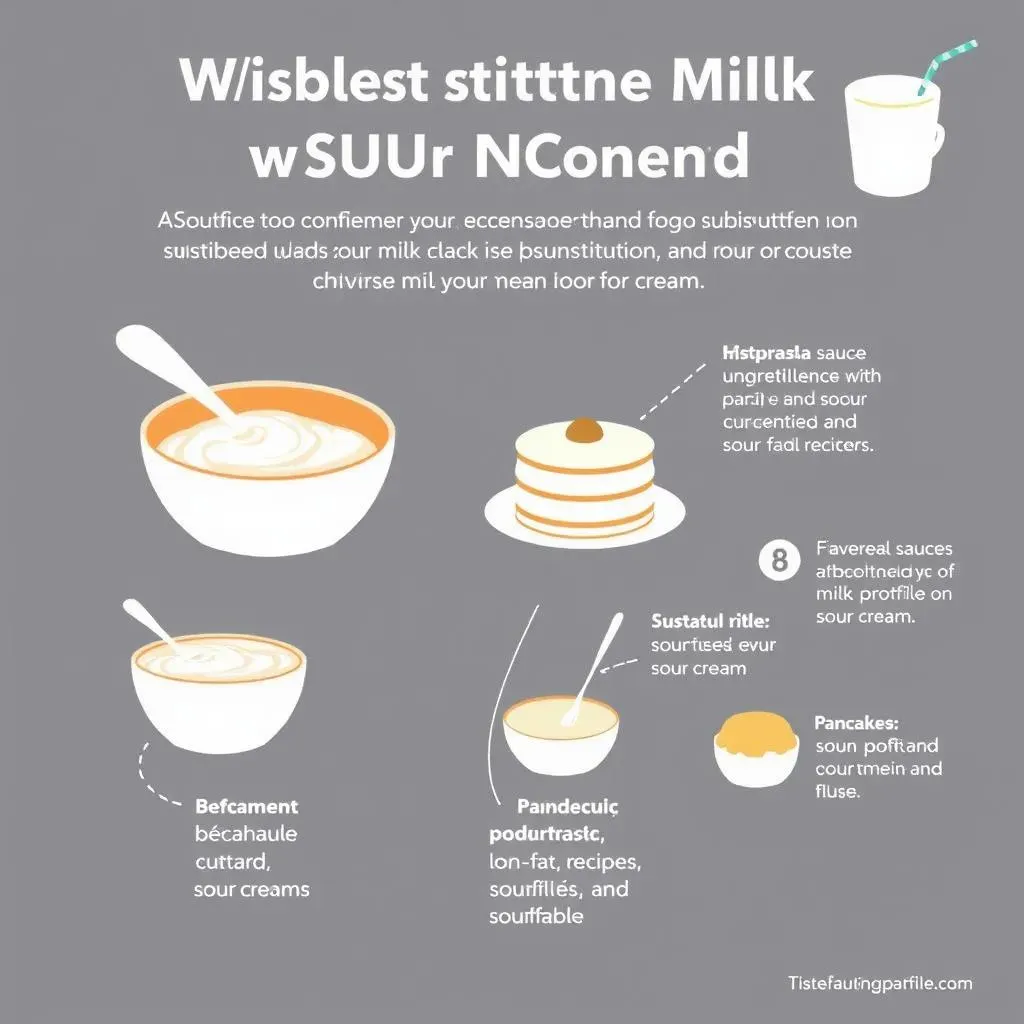Table of Contents
Ever find yourself mid-recipe, only to discover you're completely out of milk? It's a kitchen crisis we've all faced. But before you abandon your baking dreams, consider this: sour cream can be a surprisingly effective substitute for milk. I know, it sounds a little strange, right? But trust me, this isn't some desperate cooking hack; it's a legitimate technique that can save your recipe, and maybe even make it better. This article will guide you through the ins and outs of using sour cream when you need to substitute milk. We'll explore why this swap works, how to make the substitution correctly, and what adjustments you might need to make to achieve the perfect texture and taste. We’ll also cover when this substitution might not be the best idea. So, let’s get started and learn how to confidently substitute milk with sour cream, turning those kitchen mishaps into culinary wins.
Why Use Sour Cream as a Milk Substitute?

Why Use Sour Cream as a Milk Substitute?
The Unexpected Kitchen Hero
Okay, let's be honest, sour cream probably isn't the first thing that pops into your head when you're out of milk. But it's actually a pretty clever swap. See, both milk and sour cream bring moisture to a recipe, but sour cream has a higher fat content. This can lead to some seriously delicious results, especially in baked goods. It's like a secret weapon for extra richness and tenderness. Also, I've found myself in this situation way more than I'd like to admit, it's a lifesaver.
Think about it: that tangy flavor profile can also add a subtle depth that milk just doesn’t have. It's not overpowering, but it's there, adding a little extra something special. It's why a lot of old recipes call for it. The fat in the sour cream helps to create a moist texture, which is particularly useful in things like cakes and muffins. Plus, let's face it, sometimes you just don't want to run to the store.
Fat Content Advantage
The higher fat content in sour cream isn't just about richness, it also plays a crucial role in how your baked goods turn out. Fat helps to tenderize gluten, which means you’ll get a softer, more delicate crumb in your cakes and muffins. That's why sometimes, the recipes that call for sour cream are the best recipes. It also makes things less likely to dry out, which is a huge plus when you're not a fan of dry cakes. So, it's not just about replacing the milk, it's about improving on it.
And let's not forget the added bonus of that slight tang! It can cut through the sweetness in a recipe, providing a more balanced flavor profile. It's subtle, but it's there, making everything just a little bit more interesting. It's like a secret ingredient that elevates your cooking. Plus, if you’re like me, you might even have sour cream in your fridge more often than milk, making it a convenient swap.
Benefit | Why It Matters |
|---|---|
Richness | Adds depth and flavor. |
Moisture | Prevents dryness, makes baked goods softer. |
Tang | Balances sweetness, adds complexity. |
Convenience | Often available when milk isn't. |
How to Substitute Milk with Sour Cream in Recipes

How to Substitute Milk with Sour Cream in Recipes
The Basic Swap
Okay, so you're ready to ditch the milk and embrace the sour cream. The good news is, it's not rocket science. For most recipes, you can start by using about half the amount of sour cream as you would milk. So, if a recipe calls for one cup of milk, start with half a cup of sour cream. This is your starting point, and you might need to tweak it a bit depending on the recipe. It's always better to start with less and add more if needed. I've learned this the hard way, trust me, a little extra sour cream can quickly make things too thick.
The key here is to watch the consistency of your batter or sauce. You're aiming for that same smooth, pourable texture that milk would give you. If it's too thick, you can add a splash of water or milk (if you happen to have some hiding in the back of the fridge) to thin it out. Remember, sour cream is much thicker than milk, so you'll need to adjust accordingly. It might take a couple of tries to get it just right, but don't worry, you'll get the hang of it. Think of it as a little experiment in your kitchen.
Adjusting for Thickness
Now, let's talk about that thickness factor. Sour cream's extra density can sometimes lead to a batter or dough that's a bit too heavy. This is where a little extra liquid can come in handy. As I mentioned before, a splash of water or milk can help to get things moving. But sometimes, you need a bit more than just a splash. If you find your batter is still too thick, you might want to add a tablespoon at a time until you reach the desired consistency. It’s like you are training your eye to know how much liquid to add.
Another trick I've picked up over the years is to mix the sour cream with a bit of the recipe's other liquid ingredients before adding it to the rest of the batter. This helps to loosen it up and makes it easier to incorporate evenly. Also, if you're using sour cream in a sauce, you might want to thin it out with a bit of broth or cooking water to prevent it from becoming too thick and clumpy. It's all about finding the right balance.
Milk | Sour Cream | Additional Liquid |
|---|---|---|
1 cup | 1/2 cup | Adjust as needed |
2 cups | 1 cup | Adjust as needed |
1/2 cup | 1/4 cup | Adjust as needed |
Baking Soda Boost
Here's a little secret that can make a big difference, especially when you're baking: baking soda. Because of the acidity of sour cream, you might want to add a tiny pinch of baking soda to your recipe. This helps to neutralize the acidity and can contribute to a better rise and texture in your baked goods. It's not always necessary, but it’s a good trick to have up your sleeve. I've noticed that it makes a real difference in things like cakes and muffins, giving them a lighter, fluffier texture.
Start with just a 1/4 teaspoon of baking soda for every cup of sour cream you're using, and see how it goes. You can always add a little more if you feel it's needed, but be careful not to overdo it, or you might end up with a weird soapy flavor. It's like seasoning, you want to enhance the flavor, not overwhelm it. It's one of those small details that can really elevate your baking game, and it's something I always keep in mind when I'm using sour cream as a milk substitute. It's not essential, but it’s a nice tweak to consider.
Adjusting for Taste and Texture When You Substitute Milk with Sour Cream

Adjusting for Taste and Texture When You Substitute Milk with Sour Cream
The Tang Factor
Alright, so you've got the substitution down, but what about that signature sour cream tang? It's not a bad thing, but it can be a bit strong in some recipes. If you're not a fan of that extra zing, there are a couple of things you can do. First, try using a full-fat or even a reduced-fat sour cream, as they tend to have a milder flavor than the non-fat versions. I've found that the full-fat option still gives that richness without the overpowering tang. It's a delicate balance, so experiment a little to see what works best for your taste buds.
Another trick is to add a touch of sweetness to the recipe. This could be a little extra sugar, honey, or even maple syrup. The sweetness helps to balance the tang, making it less noticeable. It’s like a flavor seesaw, you need to find the right balance. But, be careful not to overdo it, you don't want to end up with a dessert when you were going for a savory dish. The goal is to complement the flavors, not mask them completely. It’s all about playing around and seeing what you like.
Texture Tweaks
Now, let's talk about texture. Because sour cream is much thicker than milk, it can sometimes make your baked goods a little denser than you might like. To combat this, try adding a bit more liquid to your recipe. This could be a tablespoon or two of water, milk, or even a little bit of the recipe’s other liquid ingredients. The key here is to add it gradually, mixing it in until you achieve the desired consistency. You're looking for a batter that's smooth and pourable, not thick and gloopy. It's a bit like adding paint to a canvas, you want it to flow smoothly.
Also, if you're using sour cream in a sauce, you might want to thin it out a bit before adding it to the rest of the ingredients. This will help it to incorporate more evenly and prevent it from clumping. I’ve found that a little bit of warm broth or cooking water works wonders for thinning out sour cream. It's all about being mindful of the texture and making adjustments as needed. It's like you are a chef and you need to know how your ingredients behave.
Issue | Solution |
|---|---|
Strong Tang | Use full-fat or reduced-fat sour cream, add a touch of sweetness |
Dense Texture | Add extra liquid, thin out sauces before adding |
A Balancing Act
Ultimately, adjusting for taste and texture when you substitute milk with sour cream is all about finding the right balance. It's not a one-size-fits-all solution, and you might need to experiment a little to see what works best for your particular recipe. Don't be afraid to try different things and make adjustments as you go. Cooking is a bit like a science experiment, you’re testing and tweaking until you get it just right. And remember, even if things don’t turn out perfect the first time, you can always learn from your mistakes and try again. It's all part of the fun of cooking.
When Not to Substitute Milk with Sour Cream

When Not to Substitute Milk with Sour Cream
When the Swap Isn't So Smart
Okay, so we've established that sour cream can be a pretty awesome milk substitute, but let's not get carried away. There are definitely times when it's just not the right choice. For instance, if you're making something where milk is a primary flavor component, like a classic béchamel sauce or a delicate custard, the tang of sour cream might throw things off. Think of it like trying to replace your guitar with a tuba – sure, they both make noise, but they're not exactly interchangeable. Also, in recipes where a very thin consistency is needed, like some types of pancake batter, sour cream will make it too thick. It's about knowing the limits of your ingredients, just like a good mechanic knows which tool to use.
Another situation where you might want to steer clear of the sour cream swap is when you're working with a recipe that specifically calls for low-fat or skim milk. In these cases, the higher fat content of sour cream could alter the balance of the recipe, potentially leading to a final product that's too heavy or greasy. It's like trying to build a lightweight racing car with heavy-duty truck parts, it's just not going to work. Also, if you're making something that's supposed to be very light and airy, like a soufflé, the density of sour cream could weigh it down. It’s all about respecting the nuances of each recipe, like a good artist respects their materials.
Situation | Why Avoid Sour Cream? |
|---|---|
Milk is a Key Flavor | Sour cream's tang can clash with delicate flavors. |
Thin Consistency Needed | Sour cream is too thick. |
Low-Fat Recipes | Sour cream's high fat content can alter the balance. |
Light and Airy Dishes | Sour cream can make the dish too dense. |
The Flavor Factor
Let's really zoom in on that flavor thing, because it's pretty important. That tang, that little zing that sour cream brings, it’s not always welcome. If you're making something with a really delicate flavor profile, like a light lemon cake or a subtle herb sauce, the sour cream can easily overpower the other ingredients. It's like a loud guest at a quiet dinner party, it just doesn't quite fit. Also, if you're aiming for a really neutral flavor, like in a simple white sauce, the sour cream will definitely make its presence known. So, while that tang can be a nice addition in some cases, it's crucial to consider how it will play with the other flavors in your recipe. It's all about being mindful of the flavor profile, like a musician is mindful of the harmony.
Additionally, think about the overall balance of your recipe. If you've already got a lot of acidity going on, like from lemon juice or vinegar, adding sour cream could push things over the edge. It’s like adding more salt to a dish that’s already salty, it’s just too much. Also, if you're trying to create a very specific flavor profile, using sour cream as a substitute could throw it off. So, it’s always a good idea to take a step back and think about how all the different elements in your recipe will work together before you make that substitution. It's all about creating a harmonious blend of flavors, like a painter blends colors on a canvas.
When to Stick with Milk
So, when in doubt, it's often best to stick with milk, or at least consider other alternatives. If you're unsure how sour cream might affect your recipe, it's always a good idea to do a little research or consult a reliable recipe source. It's like consulting a map before you embark on a road trip, it's always good to know where you're going. Also, if you have other milk substitutes on hand, like almond milk or oat milk, they might be a better choice in situations where you're worried about the sour cream's tang or texture. It's about being resourceful and using the tools that are best suited for the job. And remember, there's no shame in admitting that sometimes, the original is just the best. It's like a classic novel, sometimes it’s best not to rewrite it.
Wrapping Up: The Sour Cream Substitute Secret
So, there you have it. Substituting milk with sour cream isn't just a last-ditch effort; it's a versatile technique that can enhance your cooking and baking. While it's not a perfect one-to-one swap, understanding the nuances—like adjusting for thickness and acidity—can lead to surprisingly delicious results. Remember, a little experimentation can go a long way in the kitchen. Don't be afraid to try this substitute when you're in a pinch, and you might just discover a new favorite way to bake and cook. Now, go forth and conquer your kitchen, armed with the knowledge of the sour cream substitute!